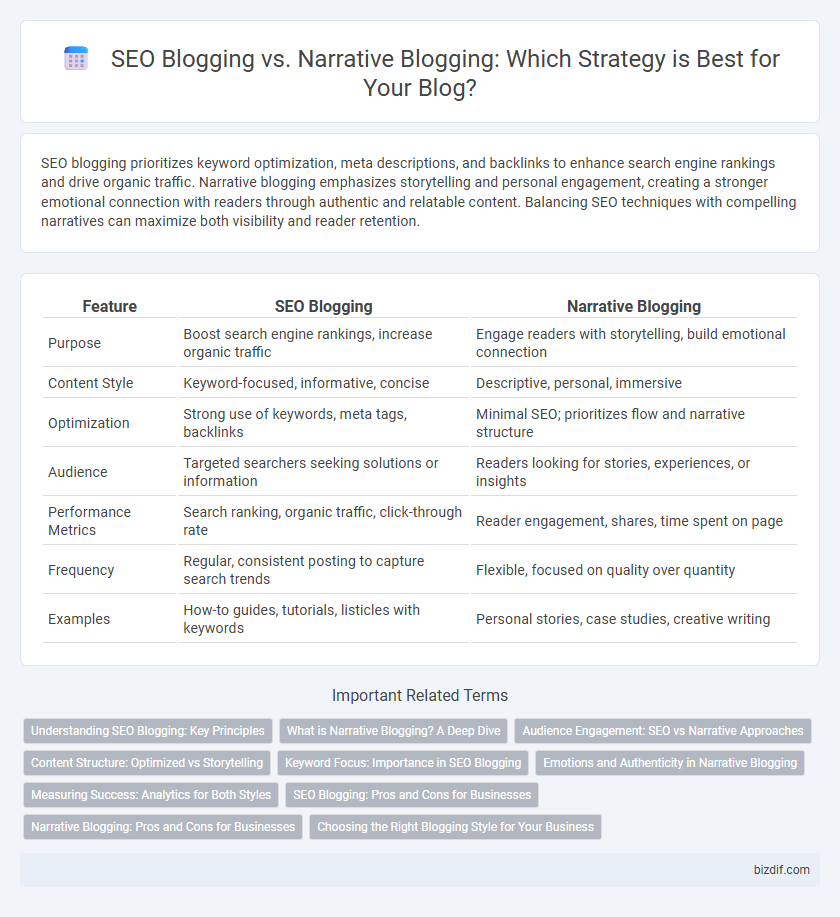SEO blogging prioritizes keyword optimization, meta descriptions, and backlinks to enhance search engine rankings and drive organic traffic. Narrative blogging emphasizes storytelling and personal engagement, creating a stronger emotional connection with readers through authentic and relatable content. Balancing SEO techniques with compelling narratives can maximize both visibility and reader retention.
Table of Comparison
| Feature | SEO Blogging | Narrative Blogging |
|---|---|---|
| Purpose | Boost search engine rankings, increase organic traffic | Engage readers with storytelling, build emotional connection |
| Content Style | Keyword-focused, informative, concise | Descriptive, personal, immersive |
| Optimization | Strong use of keywords, meta tags, backlinks | Minimal SEO; prioritizes flow and narrative structure |
| Audience | Targeted searchers seeking solutions or information | Readers looking for stories, experiences, or insights |
| Performance Metrics | Search ranking, organic traffic, click-through rate | Reader engagement, shares, time spent on page |
| Frequency | Regular, consistent posting to capture search trends | Flexible, focused on quality over quantity |
| Examples | How-to guides, tutorials, listicles with keywords | Personal stories, case studies, creative writing |
Understanding SEO Blogging: Key Principles
SEO blogging centers on strategically incorporating targeted keywords, meta descriptions, and internal links to enhance search engine visibility and drive organic traffic. It prioritizes content structure, readability, and relevance to align with search algorithms while maintaining user engagement. Mastering these principles improves website rankings and attracts a targeted audience effectively.
What is Narrative Blogging? A Deep Dive
Narrative blogging centers on storytelling, engaging readers by weaving personal experiences and emotions into compelling content that fosters connection and authenticity. Unlike SEO blogging that targets keyword optimization for search engine rankings, narrative blogging prioritizes reader engagement and emotional resonance to build a loyal audience. This approach enhances brand identity by creating memorable, relatable content that encourages sharing and long-term interaction.
Audience Engagement: SEO vs Narrative Approaches
SEO blogging prioritizes keyword optimization, meta descriptions, and structured content to increase visibility on search engines, effectively attracting targeted traffic. Narrative blogging emphasizes storytelling techniques, emotional connection, and authenticity to foster deeper audience engagement and build loyal readers. Combining SEO strategies with compelling narratives can enhance both search rankings and meaningful reader interaction.
Content Structure: Optimized vs Storytelling
SEO blogging emphasizes content structure optimized with keyword-rich headings, meta descriptions, and clear internal linking to enhance search engine rankings. Narrative blogging prioritizes storytelling flow, emotional engagement, and character development to create a compelling reader experience. Effective blogging often integrates SEO-friendly formatting with authentic narrative elements to balance discoverability and audience retention.
Keyword Focus: Importance in SEO Blogging
SEO blogging prioritizes strategic keyword placement to improve search engine rankings and attract targeted traffic, making keywords essential for visibility and discoverability. Narrative blogging emphasizes storytelling and user engagement, often using keywords more naturally without strict optimization. Effective SEO blogging balances keyword density and relevance to enhance both search performance and reader experience.
Emotions and Authenticity in Narrative Blogging
Narrative blogging prioritizes emotional engagement and authenticity, creating a genuine connection with readers through personal stories and vivid experiences. Unlike SEO blogging, which focuses on keyword optimization and search engine rankings, narrative blogging fosters trust and loyalty by conveying the blogger's true voice and heartfelt perspectives. This emotional depth enhances reader retention and encourages sharing, making narrative blogs powerful tools for building a dedicated community.
Measuring Success: Analytics for Both Styles
SEO blogging success is measured primarily through metrics like organic traffic, keyword rankings, and conversion rates tracked via tools such as Google Analytics and SEMrush. Narrative blogging focuses on engagement metrics including time on page, social shares, and reader comments to assess impact and audience connection. Both styles benefit from A/B testing headlines and content strategies to optimize for either search engine visibility or storytelling effectiveness.
SEO Blogging: Pros and Cons for Businesses
SEO blogging enhances website visibility by targeting specific keywords and improving search engine rankings, driving organic traffic essential for business growth. However, creating SEO-focused content can sometimes feel mechanical, potentially sacrificing storytelling quality and audience engagement. Balancing keyword optimization with valuable, authentic content is crucial for maximizing the benefits of SEO blogging in business strategies.
Narrative Blogging: Pros and Cons for Businesses
Narrative blogging enhances brand identity by weaving compelling stories that engage audiences and foster emotional connections, improving customer loyalty and long-term retention. However, it may lack the keyword density and targeted optimization essential for high search engine rankings, potentially limiting organic traffic growth. Businesses must balance storytelling creativity with SEO strategies to maximize visibility and maintain audience interest.
Choosing the Right Blogging Style for Your Business
SEO blogging emphasizes keyword optimization, metadata, and targeted content to boost search engine rankings and drive organic traffic, making it ideal for businesses aiming to increase visibility and lead generation. Narrative blogging focuses on storytelling, engaging readers emotionally and building brand loyalty through authentic and relatable content, which suits brands prioritizing customer connection and long-term engagement. Selecting the right blogging style depends on your business goals, whether it's attracting immediate web traffic through SEO or fostering deeper relationships with your audience via compelling narratives.
SEO Blogging vs Narrative Blogging Infographic

 bizdif.com
bizdif.com